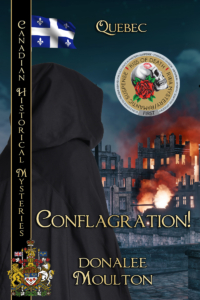The trial and tribulations of researching life – and death – in 1734
 My second mystery novel, Conflagration!, is my first historical mystery. My publisher has a series of historical mysteries than span Canada from coast to coast. When she unexpectedly lost her Quebec writer, she offered me the opportunity to write the book and step back to 1734 when the colony of New France was ruled by King Louis XV. It was an opportunity I embraced. With trepidation.
My second mystery novel, Conflagration!, is my first historical mystery. My publisher has a series of historical mysteries than span Canada from coast to coast. When she unexpectedly lost her Quebec writer, she offered me the opportunity to write the book and step back to 1734 when the colony of New France was ruled by King Louis XV. It was an opportunity I embraced. With trepidation.
At readings and book clubs, I joke that I am not from Quebec, I do not speak French as more than 80% of Quebecers do, and I do not write historical mysteries. So, of course, I said “yes” when my publisher offered me the opportunity to write Conflagration!. I am grateful I did.
What scared me most about the writing the book was getting something wrong. Misspeaking. Misunderstanding. Misconstruing. The foundation for Conflagration! (and for all historical mysteries) is accuracy. As a freelance journalist, I am used to writing on topics that I knew little (and somethings nothing) about. I have written articles on everything from buying cyber insurance to surviving a helicopter crash to paying the tooth fairy. I know how to research, how to interview people, how to find people to interview, and how to find accurate sources of information. For the most part though, the research I’ve done was contemporary or contemporary adjacent. It wasn’t from 300 years ago.
Conflagration! chronicles the arrest, trial, and subsequent execution of Marie-Joseph Angélique, an enslaved Black woman accused of setting the lower town of Montreal on fire. When the flames were finally squelched, forty-six homes and buildings were gone. The quarter, where the merchants lived and ran their businesses, was destroyed. Fortunately, no one died.
I had never heard of Angélique, had never read her story in the many history classes I took throughout school and university. I was not alone in this lack of knowledge. That is because Angélique’s story is also the story of slavery in Canada, and for centuries we have avoided the topic or rewritten the facts to shape the narrative. Fortunately,
Angélique’s story is more well known in Quebec, where a plaque has been erected in her memory in Old Montreal.
As I delved into the events of April 10, 1734, I discovered others had gone before me. There were books, websites, articles, documentaries, shorts. I embraced them all. Some of these sources also referenced court documents, meticulously recorded, albeit in French. One site translated those documents although translations from old French to modern English are not always clear and understandable. The golden rule in journalism is you must have at least two sources before you use any information. I also embraced this rule.
As nerve-wracking as ensuring my story accurately referenced the trial transcripts and sequence of events from the first flames to Angélique’s final breath, I discovered that the justice system was only one element of research required. At one point, I had my main character Philippe Archambeau, a court clerk assigned specifically to document Angélique’s case, get up early and make himself a cup of coffee. Then I asked myself, “Did they drink coffee in New France in 1734?” (They did, but tea was more common.)
This issue of everyday life came up in a myriad of ways. Philippe goes to put on boots. (Did they wear boots three hundred years ago? What kind?) His wife, Madeleine, is making supper. (How do you make supper when there are no stoves, no ovens, no electricity? What do you eat?)
The answers to these and a multitude of other questions were answered thanks to reliable sources on the internet, books written by authoritative sources, individuals knowledgeable about aspects of the story, the time, the history – and more.
I owe them all a debt of gratitude.

